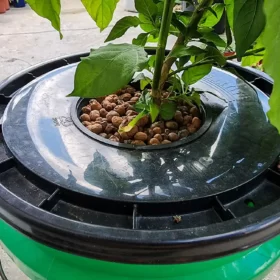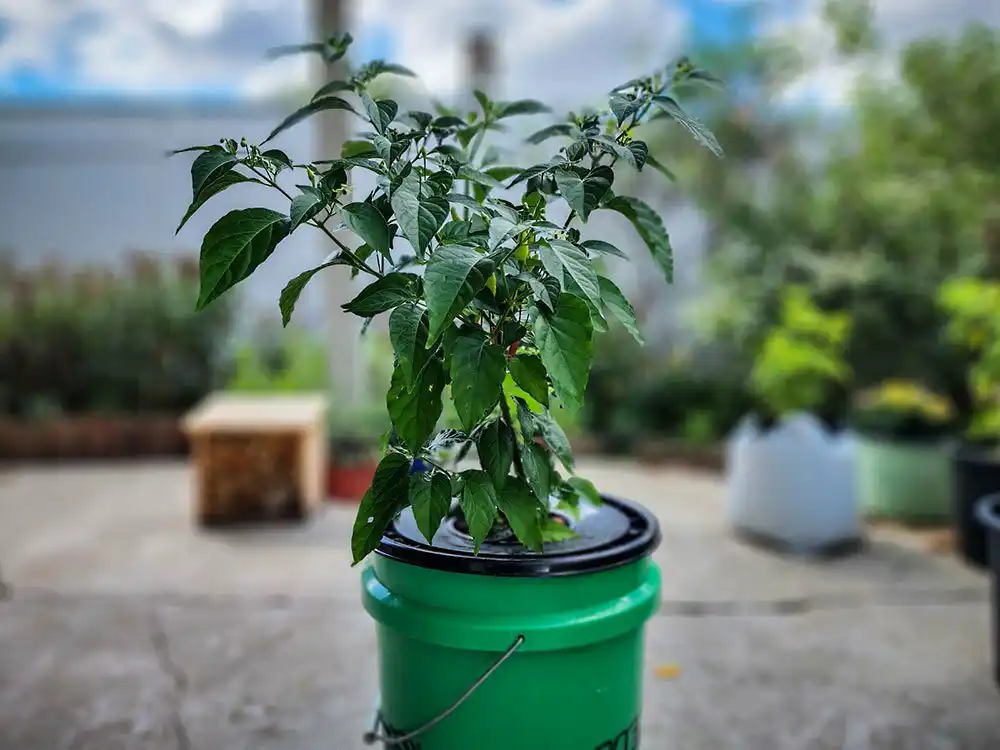Vegetable Gardening
Grow Hydroponic Peppers Using the Kratky Method
There are many options when it comes to growing peppers. You can grow them in the ground or in raised garden beds, and several different types of hydroponic systems. In recent years the Kratky method has shown strengths when growing plants outdoors since it requires no electricity.
The Kratky method is what most people would typically think of when you say hydroponic… plant roots suspended in water. If you’re looking for a soilless option you should consider growing hydroponic peppers using the Kratky method.
What Is The Kratky Hydroponic Method
Growing hydroponic peppers using the Kratky method is relatively simple. In short, you’ll be growing plants with their roots hanging in a reservoir filled with water and all the nutrients your plants need to, not only to survive but thrive! There are only a few things you’ll need to get started which we’ll go over below.
Kratky is the preferred hydroponic method for outdoor growers because it requires no pumps or components that require electricity.
Indoors or Outdoors
The Kratky method can be used indoors or outdoors. However, there are a few caveats when growing outdoors that you won’t have to worry about indoors. First there is the possibility of rainwater getting into the buckets and diluting the nutrients. This can be combated by using plastic or other material to divert water away from the net pot opening.
Another issue can be the sun beating on the bucket and warming the nutrient temperature up to the point that the plants will suffer. Painting the outside of the buckets white or wrapping them in a reflective material will help reduce the temperature.
Pros: Hydroponic peppers using Kratky
- Excellent growth
- Simple setup
- Low maintenance
- Requires no electricity
Cons of the Kratky method
- Can be difficult to support large plants
- Rain can flood buckets
- Sun can overheat nutrients
Supplies: Hydroponic Peppers Using Kratky
First, we’ll discuss the “must have” items you’re going to need for growing peppers using the Kratky method. These items can be purchased at your local hydroponics store or on Amazon.
Rockwool
If you’ve grown anything using any method of hydroponics, then you’re likely familiar with rockwool. This is the most common medium used to start hydroponic seedlings. We recommend using 1.5″ rockwool cubes for peppers.
- Made from molten rock spun into cotton candy-like fibers and then compressed into cubes, blocks, or slabs
The name rockwool comes from the manufacturing process of heating rock to a molten state and spinning it into fibers. These fibers are then compressed into the sheets or cubes that have the appearance of fiberglass insulation. Excellent at retaining moisture and inert, they are perfect for starting seedlings for hydroponics.
Nutrient Reservoir
You’ll need a nutrient reservoir for growing hydroponically using the Kratky method. This can be any waterproof vessel. Most commonly, a 5-gallon bucket is used. The most common reasons for using a 5-gallon bucket are because they are inexpensive and one-piece lids that incorporate a net pot are available.
Buckets can be purchased at Home Depot or other big box stores but if you may even be able to score some from a restaurant for free as many get things like pickles and such shipped in them.
Nutrients: Hydroponic peppers using Kratky
Since there will be no soil or compost, the hydroponic nutrients provide your plants with everything they need to grow and thrive. They are available from many manufacturers but all serve a similar purpose. Some come in liquid form while others come in powder form.
For growing our peppers hydroponically we use Masterblend, they’re the best hydroponic nutrients for vegetables. They have a long shelf life, easy to store, and very cost effective compared to most hydroponic nutrients that come in a liquid form.
Net Pots

If you’re using a 5-gallon bucket for a reservoir, we recommend using hydroponic bucket lids. They have a net pot molded into them and require no drilling.
If you’re using a vessel other than a 5-gallon bucket or prefer to drill your own hole in a bucket lid, 3″ net pots can be purchased separately. We drill our own lids as you can see in the photos, just make sure the holes are not too big for the small lip of the net pots.
Another reason we recommend hydroponic bucket lids is that if the drilled hole is too large you also risk the weight of a large plant to cause the net pot to fall through the hole.
While hydroponic bucket lids are a bit more expensive than drilling holes and using regular net pots, consider them an investment as they can be used over and over.
- Use these pots with any of your favorite growing media to ensure even drainage and promote bigger, healthier roots
Hydroton
Hydroton are clay pellets (pictured) that do nothing more than give the plant some support in the net pot, mainly during the seedling stage. They will also help prevent algae from growing in the nutrient reservoir by blocking light. The lightweight pellets can be substituted with washed gravel in a pinch.
Optional but recommended items
These are these that you may want to pick up if you get serious about hydroponics.
Gram Scale
A gram scale is useful for weighing the powdered nutrients precisely such as Masterblend nutrients. However, you can get within an acceptable range when measuring by volume as well.
pH Meter
The pH of the nutrients directly affects the plant’s ability to uptake the nutrients. Most plants grown hydroponically, including peppers, need the pH of the nutrient water to be between 5.8-6.2, we tend to shoot for the lower side of that range.
- Easy auto. calibration with buffer recognition; auto. temp. compensation (ATC) ensures accuracy in various temperatures (32 to 122F)
You can find a cheap pH meter on Amazon but if you get serious about hydroponics, we recommend investing in the best pH meter you can afford.
EC Meter
EC stands for electrical conductivity. The EC cannot tell what ratio of each nutrient in the water but gives a good indication of nutrient strength when mixing a fresh batch of nutrients. We use this EC meter which also measures TDS and temperature. They work well and seem to last.
How To: Hydroponic Peppers Using Kratky
Starting The Seedlings
Growing hydroponic peppers using Kratky method starts with the rockwool cubes and getting the seedlings growing. Starting seeds in rockwool is simple. Soak the rockwool completely in plain water. You’ll then need to remove excess water with a couple swift shakes. It should be damp but not soaking wet. Make a hole in the rockwool to about a quarter inch, no more than a half inch deep for peppers. Then drop the pepper seed into the hole and place in something to retain moisture.
A standard seed tray and humidity dome would work. Keeping the rockwool cubes, and seeds, at a temperature greater than 75F greatly speeds up germination times. Once the seedlings pop up, it shouldn’t take long and you’ll see roots growing out of the fibers. Once a few good roots are developing and the seedlings have a couple sets of leaves they’ll be ready to transplant into buckets.
Filling the Kratky Buckets With Nutrients
Having an extra 5-gallon bucket will help with getting started. Mix up 5 gallons of the Masterblend hydroponic nutrients per the manufacturer’s instructions in one bucket. On the other bucket, set the hydroponic bucket lid, no need to snap into place yet.
Now pour nutrients from the first bucket into the second bucket through the net pot opening in the bucket lid. If you’re using the hydroponic bucket lids from our link, you should fill the bucket until the nutrient water level is about an inch above the bottom of the net pot mesh.
Transplant the Seedlings

Now that your Kratky bucket is filled with nutrient water to the proper level it’s time to transplant the seedlings. Snap the hydroponic bucket lid securely onto the bucket. Now put a small handful of Hydroton, or pebbles, into the net pot just higher than the nutrient level. At this point you can place the seedling, in its rockwool cube, on top of the Hydroton.
Then fill the net pot with more Hydroton to the top of the rockwool cube. The roots of the seedling should be close to, or touching, the nutrients but you don’t want the rockwool sitting in the nutrient water else you risk the stem of the seedling rotting.
Even though the roots may not be submerged, they will stay moist from the humidity within the bucket. The roots will eventually grow down into the nutrient solution. As the plant consumes the nutrients and the water level drops, the roots will grow longer following the water level down (see photo). You may need to adjust the initial water level if you notice the seedlings are wilting before roots start growing out of the net pot.
Maintaining: Hydroponic Peppers Using Kratky
Once the plant has a good set of roots growing out of the net pot into the nutrients there’s not much you need to do. Just make sure the plants don’t use all the nutrients up and run the bucket dry.
If you need to replenish the nutrient water in the bucket, don’t fill it to the top. Generally, you don’t want to have more than 1/3 of the roots submerged once the plants are established.
FAQ: Growing Peppers Using Kratky
What size container for Kratky peppers?
For Kratky peppers, use a container with at least a 3-5 gallon capacity. Larger containers offer more nutrient solution, reducing the need for frequent refilling. Ensure the container is deep enough to support the root system while leaving room for air space between the water level and plant base.
What is the best hydroponic method for peppers?
The best hydroponic method for peppers is often the drip system or the nutrient film technique (NFT). These systems provide a constant flow of nutrients and oxygen to the roots, promoting vigorous growth and high yields. However, the Kratky method is also popular for its simplicity.
Do hydroponic peppers taste different?
Hydroponic peppers can taste different from soil-grown peppers. The controlled environment allows for optimized nutrient delivery, often resulting in more consistent and sometimes more intense flavors. However, the taste can also be influenced by the specific nutrients used and growing conditions.
Does Kratky need an air pump?
The Kratky method does not require an air pump. It’s a passive hydroponic system that relies on a static nutrient solution. As the plant consumes the solution, an air gap is created, providing oxygen to the roots. This simplicity is a key advantage of the Kratky method.
What are the disadvantages of Kratky?
Disadvantages of the Kratky method include limited nutrient solution, which can run out or become imbalanced, especially for larger plants. It’s less suited for long-term or large-scale growing. The static solution can also lead to issues with pH and salinity if not monitored and adjusted regularly.









